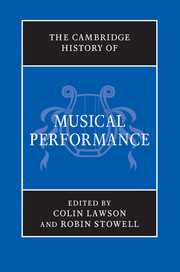Book contents
- Frontmatter
- PART I PERFORMANCE THROUGH HISTORY
- PART II PRE-RENAISSANCE PERFORMANCE
- PART III PERFORMANCE IN THE RENAISSANCE (C. 1430–1600)
- PART IV PERFORMANCE IN THE SEVENTEENTH CENTURY
- 16 Performance in the seventeenth century: an overview
- 17 Vocal performance in the seventeenth century
- 18 Instrumental performance in the seventeenth century
- 19 Case study: Monteverdi, Vespers (1610)
- PART V PERFORMANCE IN THE ‘LONG EIGHTEENTH CENTURY’
- PART VI PERFORMANCE IN THE NINETEENTH CENTURY
- PART VII THE TWENTIETH CENTURY AND BEYOND
- PART VIII
- Index
18 - Instrumental performance in the seventeenth century
from PART IV - PERFORMANCE IN THE SEVENTEENTH CENTURY
Published online by Cambridge University Press: 28 March 2012
- Frontmatter
- PART I PERFORMANCE THROUGH HISTORY
- PART II PRE-RENAISSANCE PERFORMANCE
- PART III PERFORMANCE IN THE RENAISSANCE (C. 1430–1600)
- PART IV PERFORMANCE IN THE SEVENTEENTH CENTURY
- 16 Performance in the seventeenth century: an overview
- 17 Vocal performance in the seventeenth century
- 18 Instrumental performance in the seventeenth century
- 19 Case study: Monteverdi, Vespers (1610)
- PART V PERFORMANCE IN THE ‘LONG EIGHTEENTH CENTURY’
- PART VI PERFORMANCE IN THE NINETEENTH CENTURY
- PART VII THE TWENTIETH CENTURY AND BEYOND
- PART VIII
- Index
Summary
The seventeenth century was an age of transitions. Besides developments in the construction of musical instruments and new sacred and secular compositional genres, there was a transformation of musical notation and its metrical organisation, and a new consciousness of music both as a rhetorical/poetical discipline and as an important subject within the new scientific disciplines. There was also an increasing awareness of distinct national styles, drawn into sharp focus by the documented travels between countries by important composer-performers, and a transformation of social attitudes towards music.
Performance in the seventeenth century took place in three areas, broadly defined as church, court and ‘chamber’. At the beginning of the century, instrumental idioms were hardly distinct. The question of whether keyboard pieces by J. P. Sweelinck (1562–1621) were intended for performance on organ or harpsichord was relatively unimportant. Madrigals were ‘apt for viols and voices’, Johann Woltz's keyboard anthology (1617) contained pieces that were originally issued in part-books for ensembles, and as late as 1660 the Fugues et caprices … pour l'orgue by François Roberday (1624–95) were printed in open score so that parts could easily be extracted for viols. By the end of the century, though, instrumental idioms had become far more distinct. The largest repertoires belonged to those instruments capable of polyphonic music, keyboards and the lute family, but there were astonishing developments in ensemble music. This was partly due to the development of instruments as well as to the changing genres.
- Type
- Chapter
- Information
- The Cambridge History of Musical Performance , pp. 421 - 447Publisher: Cambridge University PressPrint publication year: 2012

